The essential living room lighting trends for 2025 showcase a marriage of artistic designs and eco-conscious innovations. Sculptural fixtures serve as striking focal points, while sustainable materials enhance warmth and connection to nature. Smart, adaptive lighting offers convenience and efficiency, adapting to user preferences seamlessly. Layered illumination elevates comfort and ambiance. Unique textures and minimalist aesthetics further define modern spaces. Exploring these trends reveals an evolving landscape that transforms living environments into captivating sanctuaries.
Key Takeaways
- Sculptural lighting fixtures featuring oversized designs and organic shapes will create dramatic focal points in living room spaces.
- Emphasis on sustainable materials like wood and recycled elements will enhance eco-friendly aesthetics while connecting to nature.
- Smart and adaptive lighting systems will offer voice control and automation for personalized illumination experiences in living rooms.
- Layered and ambient lighting solutions will prioritize human well-being through optimal light distribution and color temperature adjustments throughout the day.
- Minimalist and integrated lighting designs will focus on spatial fluidity with hidden options that seamlessly incorporate into contemporary architecture.
Sculptural and Artistic Lighting
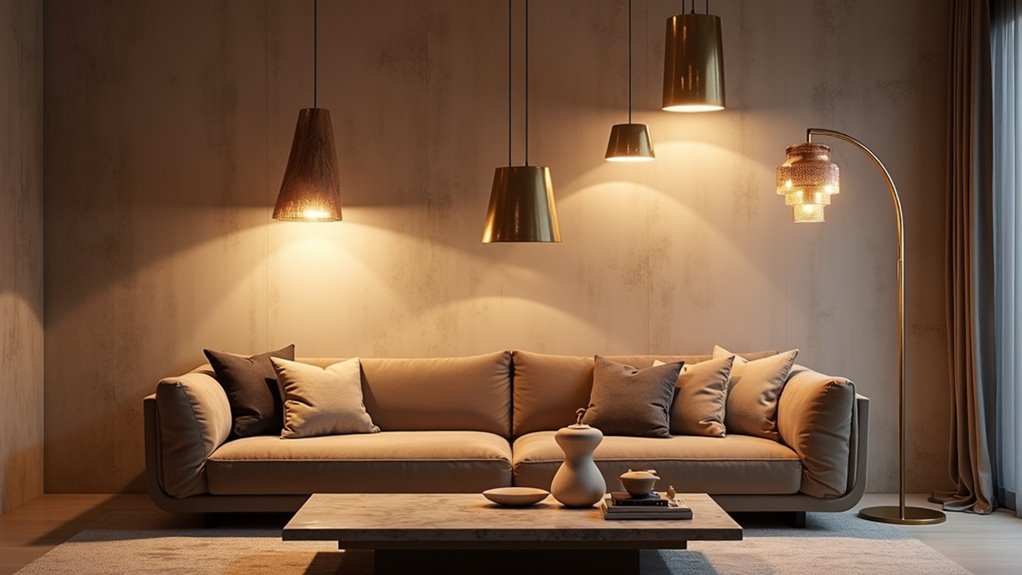
In 2025, sculptural and artistic lighting is poised to redefine the aesthetic landscape of living rooms by elevating ordinary spaces into realms of captivating design.
As lighting fixtures evolve into statement pieces, they embody sculptural aesthetics that serve not only functional roles but also ignite conversation. Oversized chandeliers and fluidly designed pendants introduce dramatic focal points, transforming any room into a gallery. Emphasizing organic shapes and unexpected materials, these designs evoke nature, with curves that soften and invite. The interplay of materials enhances the visual depth of these fixtures, ensuring that artistic illumination transcends mere utility. Additionally, the rise of smart lighting technology further enhances the artistic features of these sculptural designs, allowing for dynamic and customizable illumination that adapts to the mood of the space.
As fixtures double as sculptures, they create harmoniously layered environments that invite ambiances, ultimately reflecting personal style and enhancing the overall living experience.
Sustainable and Natural Materials

In 2025, the trend towards sustainable and natural materials in living room lighting is firmly established, driven by a growing consumer preference for eco-friendly design.
The selection of responsibly sourced materials not only addresses environmental concerns but also enhances aesthetic appeal through artisanal craftsmanship.
This shift toward eco-conscious choices signifies a deeper commitment to sustainability that transcends mere trendiness, positioning these elements as essential in modern interior design.
Eco-Friendly Material Choices
As the quest for sustainability intensifies, the integration of eco-friendly materials in lighting design emerges as a defining trend in 2025, appealing to both environmentally conscious consumers and aesthetic sensibilities.
The surge in recycled materials, like metals and glass, highlights a commitment to reducing waste while maintaining visual impact.
Innovations in eco-friendly fabrics, such as recycled polyester used to wrap LED strips, signal a shift toward responsible design.
Furthermore, natural and raw materials—wood, stone, and bamboo—celebrate organic imperfections, imbuing spaces with warmth.
This trend not only fosters a connection to nature but also aligns with biophilic principles, enhancing well-being and interiors.
Such conscious choices affirm that style and sustainability can coexist harmoniously in lighting design.
Artisanal Craftsmanship Focus
The increasing emphasis on eco-friendly materials in lighting design naturally aligns with a growing appreciation for artisanal craftsmanship, as consumers gravitate toward unique, handmade pieces that provide a personal touch in their living spaces.
Artisanal lighting not only serves as a stylistic focal point but also highlights the beauty in natural imperfections, using materials such as wood, stone, and rattan. Each fixture carries artisan stories, celebrating the skilled techniques like hand-blown glass and metal forging behind their creation.
These one-of-a-kind pieces reflect a deeper desire for authenticity and connection to craftsmanship, making them an appealing choice for discerning buyers. As the demand for sustainable, textured lighting grows, so too does the value placed on the artisans bringing these unique pieces to life.
Smart and Adaptive Lighting
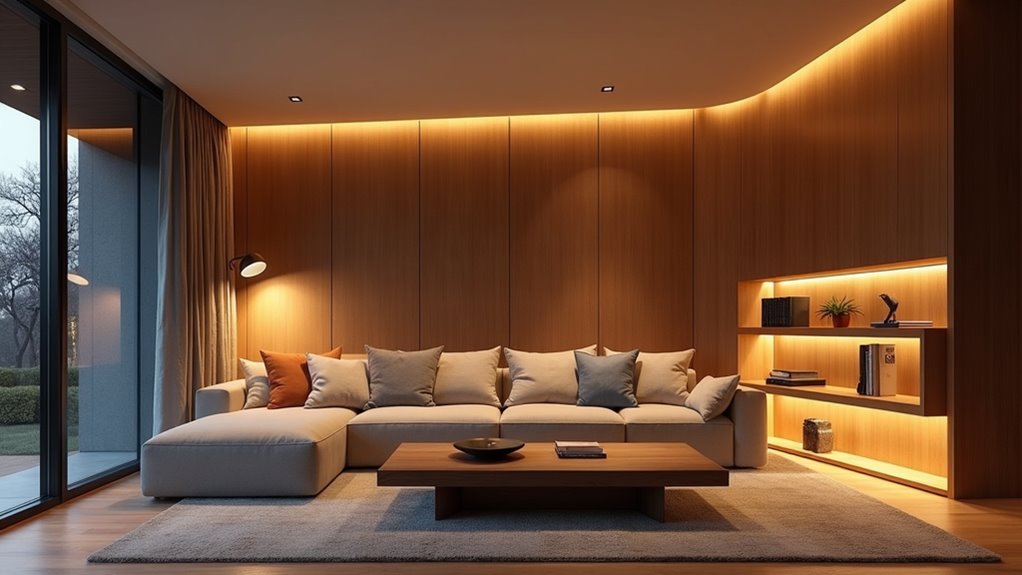
As the demand for personalized living environments grows, smart and adaptive lighting emerges as a transformative trend in interior design for 2025.
Voice-controlled lighting systems not only enhance convenience but also support circadian rhythm optimization by adjusting light settings throughout the day.
With customizable options for brightness and color, consumers can create tailored atmospheres that promote both well-being and comfort in their living spaces.
Voice-Controlled Lighting Systems
Transformative advancements in technology are reshaping the landscape of voice-controlled lighting systems, making them an integral feature of modern smart homes by 2025.
Enhanced voice recognition capabilities allow users to effortlessly command their lighting with hands-free control, integrating seamlessly with popular voice assistants like Alexa, Google Assistant, and Siri. This technology enables users to adjust brightness, color, and scenes through simple voice commands.
AI-powered adaptive lighting learns user preferences, optimizing responses based on occupancy and natural light levels, fostering personalized experiences.
Moreover, connectivity with a broader smart home ecosystem enables centralized control over multiple devices, enhancing convenience and energy efficiency.
As these trends evolve, voice-controlled lighting systems will be essential for creating dynamic living spaces tailored to individual needs.
Circadian Rhythm Optimization
With an increasing emphasis on mental and physical well-being, circadian rhythm optimization in lighting is poised to revolutionize the way living spaces are designed and utilized by 2025.
This approach mimics natural daylight patterns, allowing for light adjustment throughout the day, which significantly enhances circadian benefits. By aligning indoor lighting with the body’s internal clock, users can experience improved sleep quality and overall well-being.
Systems that automatically adjust color temperature and intensity promote effective sleep-wake cycles, which have been shown to enhance mood and increase productivity.
As consumers demand healthier environments, innovations in technology, including LED bulbs with spectral flexibility and smart home integration, will further advance the reach and effectiveness of circadian lighting solutions.
Customizable Light Settings
Customizable light settings are redefining the living room experience by offering unparalleled flexibility in illumination.
The rise of interactive light customization allows users to tailor brightness, colors, and patterns seamlessly through voice commands or apps, creating personalized lighting scenarios that cater to specific moods and activities. Integration with smart home systems amplifies this capability, ensuring that lighting can adaptively respond to user behavior, such as brightening upon entry or synchronizing with daily routines.
Additionally, AI advancements enable systems to learn preferences over time, optimizing ambiance while enhancing energy efficiency. With layered lighting options and dynamic color-changing possibilities, customizable settings not only elevate aesthetic appeal but also foster a functional environment tailored to individual lifestyles, making them essential for modern living.
Layered and Human-Centric Illumination
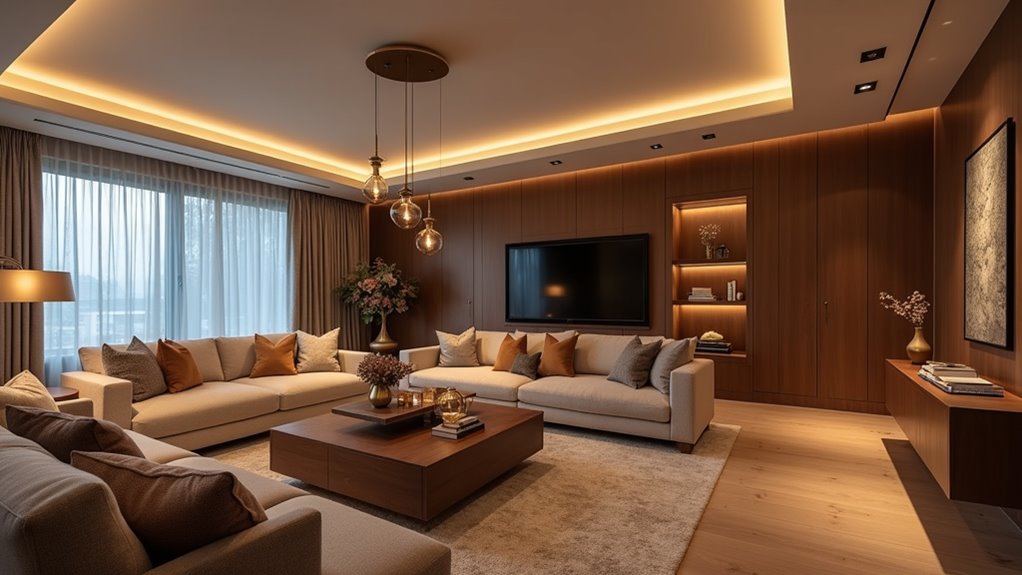
Layered and human-centric illumination stands at the forefront of contemporary living room design, integrating multiple lighting sources to enhance both aesthetic appeal and functionality. This approach moves beyond a single overhead light, creating a layered ambiance that combines ambient, task, and accent lighting. By distributing light evenly, it reduces harsh shadows and complements human-centered design principles that support well-being and productivity. The incorporation of smart technology enables dynamic adjustments to color temperature, aligning with circadian rhythms for optimal mood and comfort.
| Layer Type | Purpose |
|---|---|
| Ambient Lighting | General illumination |
| Task Lighting | Focused activities |
| Accent Lighting | Highlighting features |
| Smart Controls | Personalized adjustments |
This layered technique cultivates harmony while catering to diverse needs within living spaces.
Minimalist and Integrated Lighting
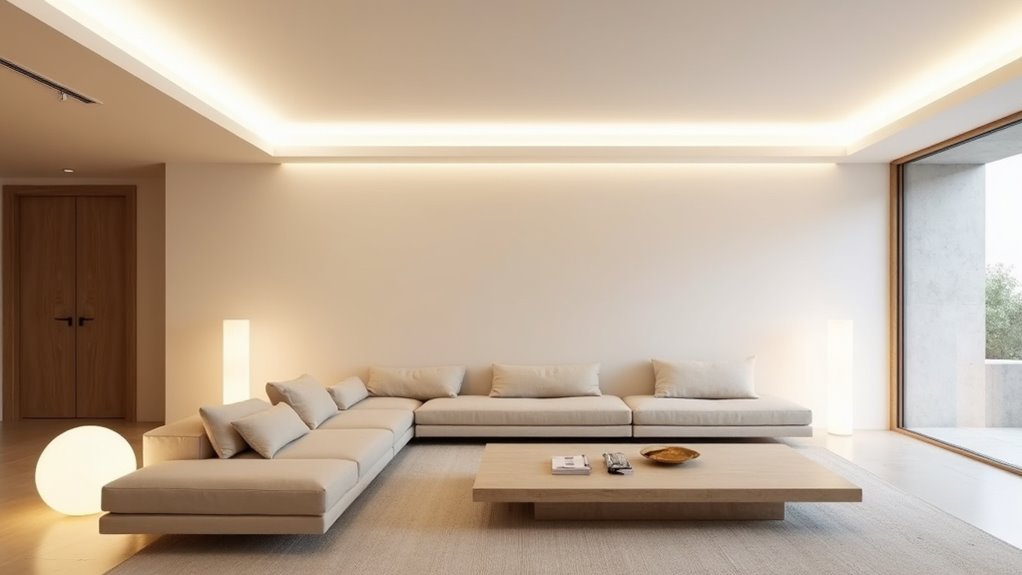
In the evolving landscape of living room design, minimalist and integrated lighting emerges as a pivotal trend, emphasizing seamless architectural integration and clean line aesthetics.
Hidden lighting solutions enhance spatial fluidity, allowing fixtures to blend effortlessly with the environment while maintaining a focus on illumination rather than on the source.
This approach not only elevates the visual appeal of interior spaces but also fosters a sense of tranquility and openness, underscoring the modern ethos of “less is more.”
Seamless Architectural Integration
Seamless architectural integration in living room lighting for 2025 is characterized by a sophisticated interplay of minimalism and technology, redefining how spaces are illuminated. This trend emphasizes unobtrusive solutions that enhance architectural features while maintaining a clean aesthetic.
Key elements include:
- Vanishing light sources through recessed lighting and hidden LED strips.
- Minimalist fixture design that prioritizes elegance and simplicity, ensuring fixtures fade into their surroundings.
- Integrated LED technology for efficient, long-lasting illumination embedded in floors, walls, and ceilings.
- Smart and seamless control systems that allow for customized lighting experiences without compromising design integrity.
Together, these elements create a refined atmosphere, showcasing architectural beauty while remaining unobtrusive to the overall design of the living space.
Clean Lines Design
Clean lines design epitomizes the essence of minimalist and integrated lighting, shaping a new narrative in living room aesthetics for 2025. This trend champions simplicity, focusing on functional elegance and the strategic use of geometric shapes and straight lines.
Fixtures such as slim pendant lights, recessed lighting, and sleek wall sconces exemplify minimalist aesthetics, ensuring every element serves a clear purpose. Neutral color palettes, including blacks, whites, and metallics, dominate, fostering a tranquil ambiance that enhances space without overwhelming it.
Such lighting solutions not only emphasize architectural features but also promote a sense of order and spaciousness. Ultimately, clean lines design proves essential in creating adaptable, clutter-free living environments while seamlessly merging with contemporary decor styles.
Hidden Lighting Solutions
As home design continually evolves, hidden lighting solutions emerge as a pivotal aspect of modern living room aesthetics, seamlessly blending practicality with sophistication. The trend emphasizes architectural integration, allowing light to enhance spaces while remaining undetectable.
- Recessed lighting provides a clean, unobtrusive option that complements ceilings.
- Hidden LED strips are easily integrated into walls and floors for subtle illumination.
- Furniture-integrated lighting, such as under-cabinet fixtures, maximizes utility without cluttering visual space.
- Smart lighting systems offer customizable atmospheres, adapting color and intensity on demand.
These innovative solutions prioritize aesthetic appeal and functionality, ensuring that light sources contribute to the ambiance while showcasing architectural beauty. Ultimately, they transform living rooms into elegant retreats.
Retro and Vintage With a Modern Twist
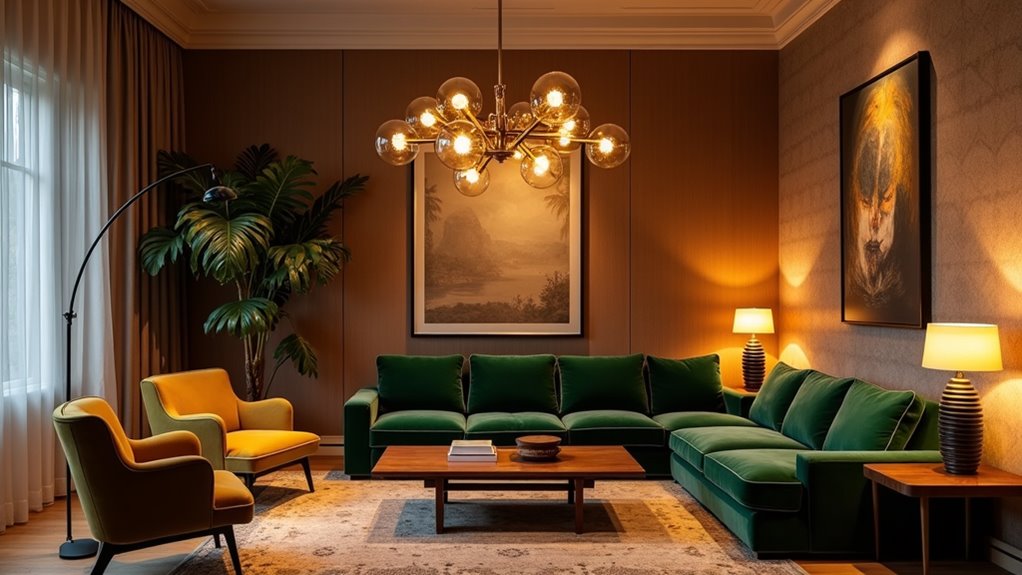
The trend of intertwining retro and vintage aesthetics with modern design elements is poised to redefine living room lighting in 2025. With a longing for retro nostalgia, designers are reimagining classic styles, such as mid-century and art deco, integrating contemporary touches. Iconic forms, like Sputnik chandeliers and globe-shaped pendants, will re-emerge with modern finishes and technology, including LED compatibility.
| Lighting Style | Features | Materials/Finishes |
|---|---|---|
| Sputnik Chandelier | Bold geometric design | Polished metals, frosted glass |
| Globe Pendant | Soft rounded shapes | Ribbed glass, vintage hues |
| Art Deco Lamps | Sleek, luxurious finishes | Aged brass, smoked glass |
| Mid-Century Fixtures | Clean lines, functional designs | Warm metallics, playful colors |
| Antique Sconces | Classic forms with modern hardware | Unique textures, modern LEDs |
This fusion creates personalized spaces that celebrate both history and innovation.
Ambient Lighting Trends
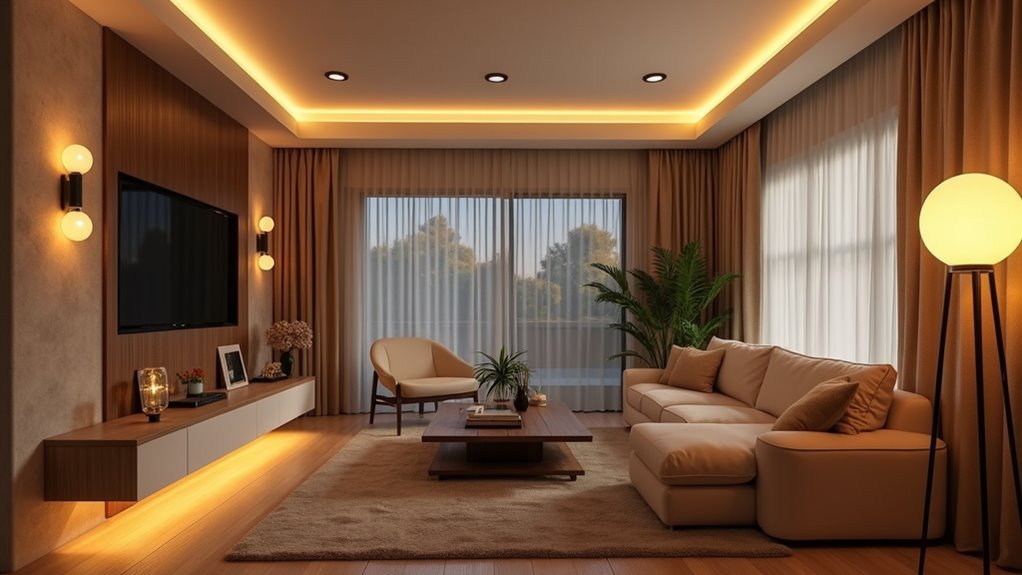
Evolving from the charm of retro-inspired fixtures, ambient lighting trends for 2025 are emphasizing comfort and adaptability in living spaces.
As a foundational element of illumination, these trends focus on enhancing the overall atmosphere while prioritizing well-being.
Key developments include:
- Smart & Adaptive Lighting: Offering intuitive control through voice commands and apps for a customizable ambiance.
- Warm & Diffused Lighting: Utilizing concealed LED strips and frosted shades to create soft, inviting environments.
- Hidden & Recessed Lighting: Ensuring a minimalist aesthetic with integrated designs that blend seamlessly into architecture.
- Sustainable Materials: Emphasizing eco-friendly fixtures and energy-efficient solutions, aligning style with responsibility.
Together, these elements foster a harmonious blend of ambient light that defines the adaptable ambiance of modern living rooms.
Statement Chandeliers and Pendants

Statement chandeliers and pendants are poised to redefine living room aesthetics in 2025, showcasing a blend of artistry and innovation.
These fixtures are evolving into true art forms, characterized by unique designs that elevate both function and style. Oversized options create dramatic impact, serving as focal points in spacious areas, while their imaginative shapes—ranging from geometric forms to organic curves—add a bold statement to the décor.
Lighting fixtures are transforming into stunning art pieces, blending imaginative designs with functionality to make bold statements in any space.
With a focus on luxury aesthetics, materials such as metallic finishes and blown glass are prevalent, enhancing the overall ambiance.
As creative craftsmanship becomes a priority, these lighting pieces not only illuminate spaces but also foster an engaging atmosphere, reinforcing the importance of integrating artistic flair in modern living environments.
Textured and Mixed Material Designs
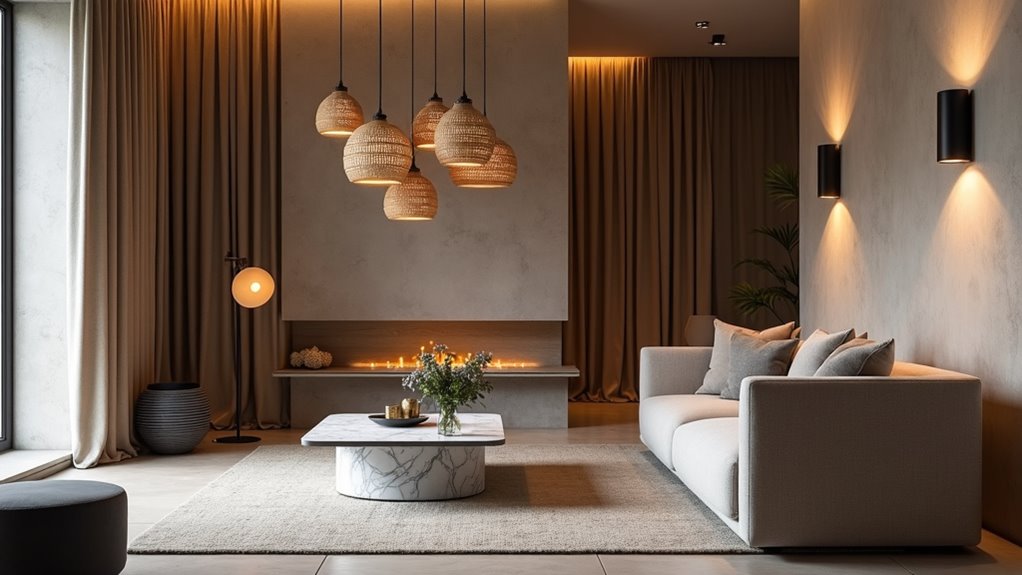
As statement chandeliers and pendants set the tone for bold living room aesthetics, the incorporation of textured and mixed material designs is gaining momentum.
These designs reflect a commitment to material harmony, showcasing the richness of textured contrasts through innovative combinations.
- Layered materials like wood and metal, rattan and iron enhance depth.
- The interplay of textured glass with brushed metal adds visual intrigue.
- Organic materials such as stone and ceramic contribute to a calming atmosphere.
- Sculptural forms invoke nature, combining organic shapes with varied finishes.
In 2025, lighting fixtures evolve from mere functional objects to captivating art pieces, melding various textures to create unique, tactile experiences that elevate living spaces.
Eco-Conscious Lighting Innovations
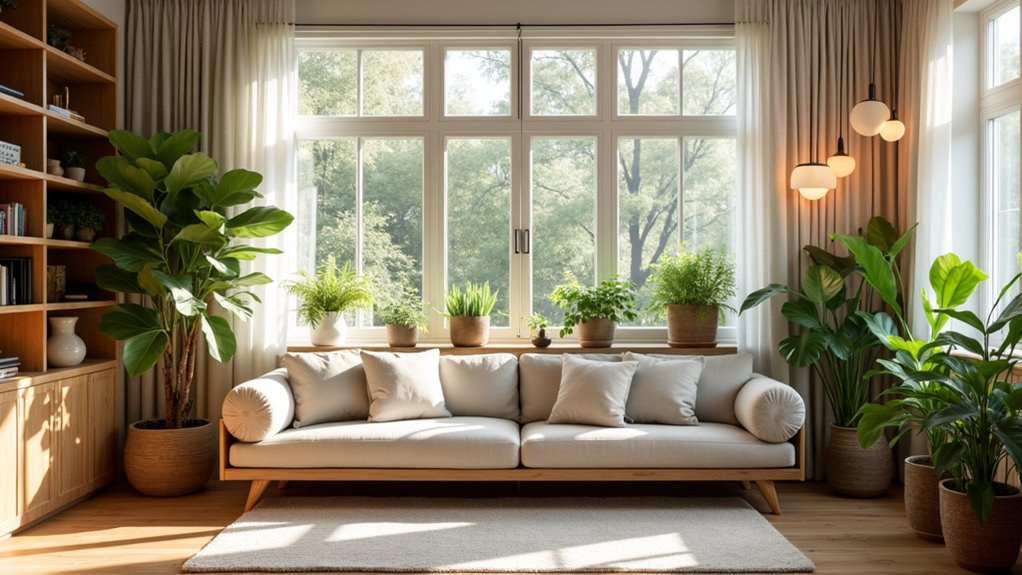
With the urgency of climate action shaping consumer preferences, eco-conscious lighting innovations are poised to dominate the market in 2025.
Advanced LED technology is set to achieve 180 lm/W efficiency, boasting 70% more energy savings than traditional options.
Meanwhile, OLEDs offer unique design flexibility and superior soft light quality, further enhancing energy efficient solutions.
Smart and AI-driven systems promise to reduce energy use by up to 70% through behavioral analysis and automated adjustments.
Additionally, the shift towards a circular economy emphasizes remanufactured fixtures and modular designs that facilitate sustainability.
Innovations will also include biodegradable components, minimizing environmental impact.
This amalgamation of technologies will create a more sustainable lighting landscape for modern living spaces.


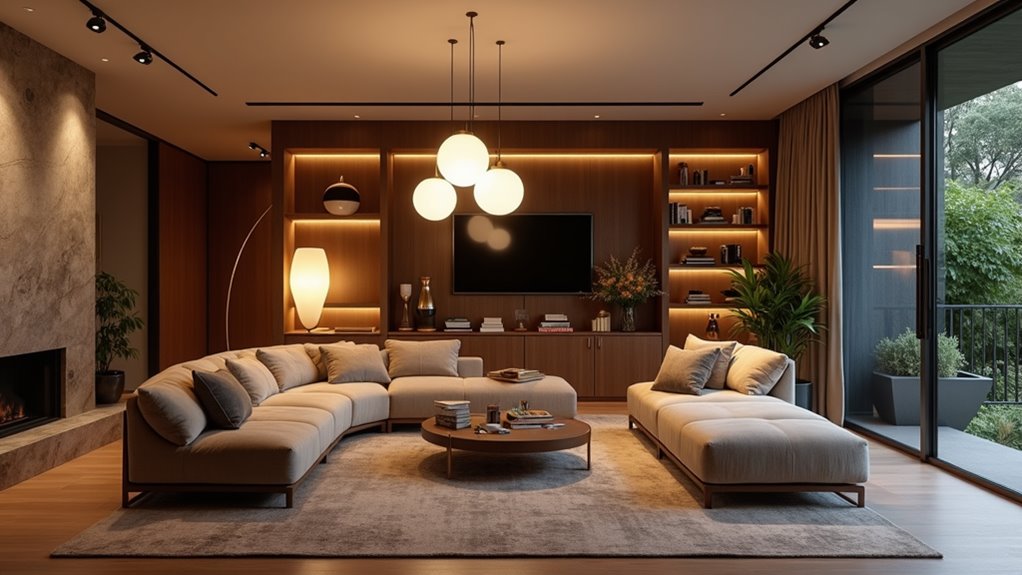
Bài viết cùng chủ đề:
7 Tips for Stunning Interior Lighting Design in Your Living Room
3 Stunning Living Room High Ceiling Lighting Ideas
7 Creative Ideas for Living Room LED Strip Lighting
7 Brilliant Living Room Lighting Solutions for Every Style
7 Tips for Creating Stunning Living Room Cove Lighting Designs
3 Brilliant Ideas for Living Room Floor Lighting